Sodium Trimetaphosphate Market
Sodium Trimetaphosphate Market Size and Share Forecast Outlook 2025 to 2035
The sodium trimetaphosphate market is projected to grow from USD 310.0 million in 2025 to USD 460.0 million by 2035, at a CAGR of 4.0%. Food & Bakery (Improvers) will dominate with a 48.0% market share, while food-grade will lead the grade segment with a 61.0% share.
Sodium Trimetaphosphate Market Forecast and Outlook 2025 to 2035
The global sodium trimetaphosphate market is projected to grow from USD 310.0 million in 2025 to approximately USD 460.0 million by 2035, recording an absolute increase of USD 150.0 million over the forecast period. This translates into a total growth of 48.4%, with the market forecast to expand at a CAGR of 4.0% between 2025 and 2035.
The overall market size is expected to grow by nearly 1.5X during the same period, supported by increasing demand for food processing additives, growing adoption of water treatment chemicals, and rising industrial applications requiring dispersant and sequestrant properties driving specialized chemical procurement across various manufacturing and processing applications.
Quick Stats for Sodium Trimetaphosphate Market
| Sodium Trimetaphosphate Market Value (2025) | USD 310.0 million |
|---|---|
| Sodium Trimetaphosphate Market Forecast Value (2035) | USD 460.0 million |
| Sodium Trimetaphosphate Market CAGR | 4.0% |
| Leading Segment by Application (2025) | Food & Bakery (Improvers) (48.0%) |
| Leading Segment by Grade (2025) | Food-grade (61.0%) |
| Leading Segment by Form (2025) | Powder (72.0%) |
| Key Growth Regions | North America, Europe, and Asia Pacific |
| Top Companies by Market Share | Innophos, Prayon, Chemtrade |
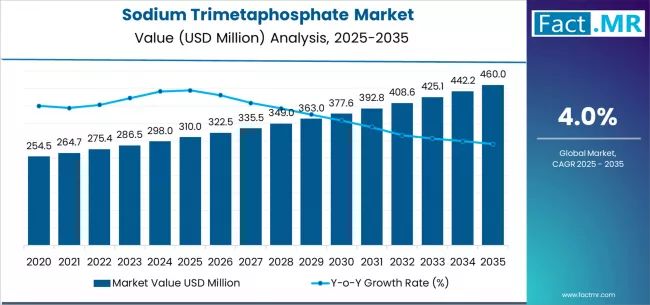
Sodium Trimetaphosphate Market Key Takeaways
| Metric | Value |
|---|---|
| Market Value (2025) | USD 310.0 million |
| Market Forecast Value (2035) | USD 460.0 million |
| Forecast CAGR (2025-2035) | 4.0% |
Why is the Sodium Trimetaphosphate Market Growing?
| FOOD PROCESSING TRENDS | WATER TREATMENT REQUIREMENTS | INDUSTRIAL APPLICATION STANDARDS |
|---|---|---|
| Global Food Processing Growth | Advanced Water Treatment Needs | Specialty Chemical Standards |
| Continuous expansion of food processing industry across established and emerging markets driving demand for specialty phosphate additive solutions. | Modern water treatment facilities requiring effective sequestrant and dispersant chemicals for scale prevention and water quality management. | Regulatory requirements establishing performance benchmarks favoring high-quality specialty phosphate chemicals in industrial applications. |
| Bakery Industry Expansion | Industrial Processing Demands | Quality Assurance Standards |
| Growing emphasis on bakery product quality and shelf-life enhancement creating demand for food-grade phosphate improver applications. | Industrial manufacturers investing in specialized chemicals offering consistent processing performance while maintaining operational efficiency. | Quality standards requiring superior dispersant properties and resistance to degradation in demanding processing environments. |
| Premium Food Additive Positioning | Quality and Performance Standards | Technical Specification Requirements |
| Superior sequestrant characteristics and food safety properties making sodium trimetaphosphate essential for premium food processing and industrial applications. | Certified chemical producers with proven performance records required for advanced water treatment and specialized industrial applications. | Diverse technical requirements and performance standards driving need for precisely specified specialty phosphate chemicals. |
Sodium Trimetaphosphate Market Segmentation
| Category | Segments Covered |
|---|---|
| By Application | Food & Bakery (Improvers), Water Treatment, Industrial (Dispersants) |
| By Grade | Food-grade, Industrial-grade |
| By Form | Powder, Solution |
| By Region | North America, Europe, Asia Pacific, Latin America, Middle East & Africa |
Sodium Trimetaphosphate Market Analysis by Application
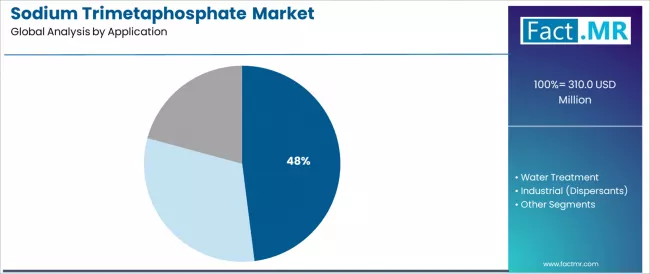
| Segment | 2025 to 2035 Outlook |
|---|---|
| Food & Bakery (Improvers) | Leader in 2025 with 48.0% market share; likely to maintain leadership through 2035. Established efficacy in dough conditioning and texture improvement with growing bakery industry expansion. Momentum: steady-to-strong. Watchouts: regulatory scrutiny on phosphate additives, clean-label trends potentially affecting usage in some premium segments. |
| Water Treatment | Strong segment with 27.0% market share due to effective sequestrant properties and scale prevention capabilities in industrial water systems. Benefits from infrastructure development and water quality requirements. Momentum: strong growth driven by industrial expansion and environmental compliance standards. |
| Industrial (Dispersants) | Represents 25.0% market share, benefiting from dispersant applications in ceramics, paints, and specialty manufacturing processes. Strong in technical applications requiring precise chemical performance. Momentum: moderate growth via specialized industrial applications and technical innovation. Watchouts: competition from alternative dispersant technologies, environmental regulations affecting certain industrial uses. |
Sodium Trimetaphosphate Market Analysis by Grade
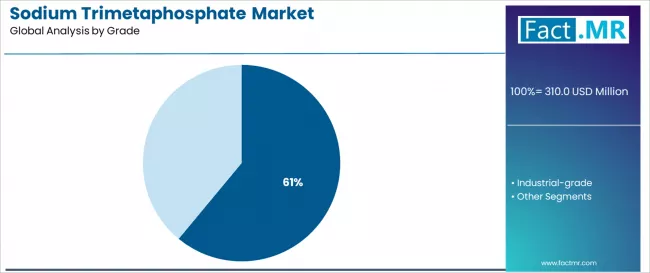
| Segment | 2025 to 2035 Outlook |
|---|---|
| Food-grade | At 61.0%, largest grade segment in 2025 with stringent purity standards and food safety compliance requirements. Mature regulatory approval processes, established quality specifications. Momentum: steady growth driven by food processing expansion and bakery industry development. Watchouts: regulatory changes affecting phosphate usage levels, consumer preference shifts toward phosphate-free alternatives in certain applications. |
| Industrial-grade | Strong segment with 39.0% share driven by cost-effectiveness and technical performance in non-food applications. Benefits from industrial processing requirements and water treatment demand. Momentum: strong growth through 2030, supported by infrastructure development and industrial expansion. Watchouts: environmental regulations on phosphate discharge, competition from alternative chemical technologies in certain applications. |
Sodium Trimetaphosphate Market Analysis by Form
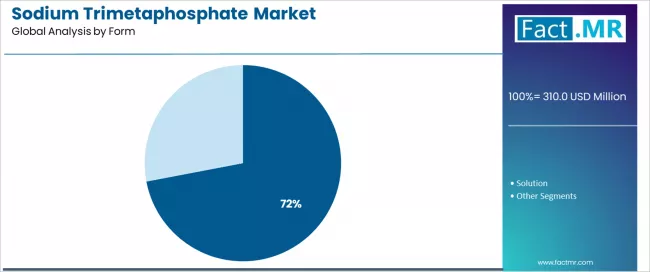
| Segment | 2025 to 2035 Outlook |
|---|---|
| Powder | Dominant segment with 72.0% market share due to handling convenience and storage stability advantages. Benefits from established packaging systems and transportation efficiency. Momentum: steady growth driven by user preference and supply chain efficiency. Watchouts: dust handling concerns, moisture sensitivity requiring careful storage and handling protocols. |
| Solution | Represents 28.0% market share, favored for direct application convenience and processing integration ease. Strong in automated dosing systems and continuous processing applications. Momentum: moderate growth in specialized applications requiring precise dosing and immediate solubility. Watchouts: transportation costs for liquid products, storage infrastructure requirements, shelf-life limitations compared to powder forms. |
DRIVERS
| DRIVERS | RESTRAINTS | KEY TRENDS |
|---|---|---|
| Global Food Processing Growth | Regulatory Restrictions | Advanced Processing Technologies |
| Continuing expansion of food processing industry across established and emerging markets driving demand for specialty phosphate additive solutions. | Increasing regulatory restrictions on phosphate usage in certain applications affecting market access and application development. | Integration of advanced dosing systems, quality control technologies, and precision application methods enabling superior performance efficiency. |
| Infrastructure Development | Environmental Concerns | Sustainable Chemistry Integration |
| Increasing recognition of water treatment importance and industrial processing requirements supporting infrastructure investment and chemical demand. | Environmental concerns about phosphate discharge and aquatic ecosystem impact affecting usage patterns and regulatory compliance. | Enhanced environmental management, recycling capabilities, and sustainable production methods compared to traditional chemical manufacturing approaches. |
| Premium Technical Performance | Alternative Technology Competition | Specialty Application Development |
| Growing demand for chemicals that support both functional benefits and processing reliability in specialized technical and food applications. | Competition from alternative dispersant and sequestrant technologies offering similar performance with different environmental profiles. | Development of specialized formulations and targeted applications providing enhanced technical benefits and performance optimization opportunities. |
Analysis of Sodium Trimetaphosphate Market by Key Countries
| Country | CAGR (2025-2035) |
|---|---|
| USA | 4.1% |
| Mexico | 3.9% |
| Germany | 3.3% |
| France | 3.2% |
| UK | 3.0% |
| South Korea | 2.9% |
| Japan | 2.8% |
USA Leads Global Market Growth with Chemical Industry Excellence
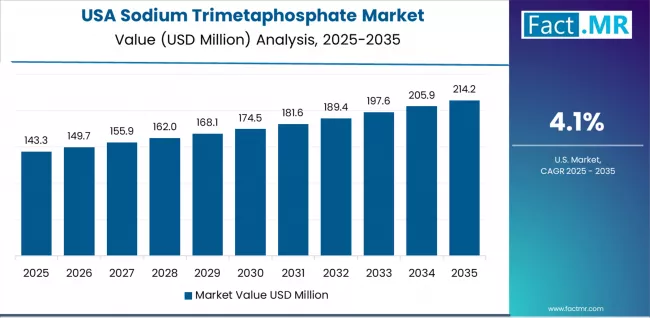
Revenue from Sodium Trimetaphosphate in USA is projected to exhibit strong growth with a market value of USD 145 million by 2035, driven by expanding specialty chemicals industry infrastructure and comprehensive food processing innovation creating substantial opportunities for phosphate suppliers across manufacturing operations, water treatment applications, and premium industrial sectors.
The country's established chemical manufacturing tradition and expanding food safety regulations are creating significant demand for both conventional and high-grade specialty phosphate chemicals. Major chemical companies and food processing manufacturers including Innophos, Chemtrade, and specialty chemical-focused brands are establishing comprehensive local production facilities to support large-scale manufacturing operations and meet growing demand for technical phosphate solutions.
- Specialty chemicals industry modernization programs are supporting widespread adoption of sodium trimetaphosphate across manufacturing operations, driving demand for high-quality phosphate chemicals
- Food processing regulation compliance initiatives and quality enhancement development are creating substantial opportunities for chemical suppliers requiring reliable performance and cost-effective specialty solutions
- Industrial processing advancement and water treatment development are facilitating adoption of specialty phosphate chemicals throughout major manufacturing and infrastructure regions
Mexico Demonstrates Strong Market Potential with Industrial Growth
Revenue from Sodium Trimetaphosphate in Mexico is expanding to reach USD 98 million by 2035, supported by extensive industrial expansion and comprehensive manufacturing industry development creating sustained demand for reliable chemical solutions across diverse processing categories and emerging industrial segments. The country's growing manufacturing base and expanding infrastructure development are driving demand for chemical solutions that provide consistent performance while supporting cost-effective processing requirements. Chemical processors and industrial suppliers are investing in local quality facilities to support growing manufacturing operations and industrial chemical demand.
- Industrial expansion operations and manufacturing capability development are creating opportunities for chemical solutions across diverse processing segments requiring reliable performance and competitive industrial costs
- Manufacturing modernization and processing technology advancement are driving investments in chemical supply chains supporting industrial requirements throughout major manufacturing regions
- Infrastructure development growth and specialty industrial programs are enhancing demand for technical-grade chemicals throughout Mexican industrial areas
Germany Maintains Leadership with Chemical Technology Innovation
Demand for Sodium Trimetaphosphate in Germany is projected to reach USD 78 million by 2035, supported by the country's leadership in chemical technology innovation and advanced industrial processing requiring sophisticated phosphate systems for manufacturing and water treatment applications. German companies are implementing high-quality chemical procurement that supports advanced processing techniques, operational efficiency, and comprehensive environmental protocols. The market is characterized by focus on operational excellence, environmental compliance, and adherence to stringent chemical safety and performance standards.
- Chemical technology innovation industry investments are prioritizing premium phosphate technologies that demonstrate superior performance and environmental compliance while meeting German industrial and safety standards
- Industrial processing leadership programs and operational excellence initiatives are driving adoption of precision-specified chemical systems that support advanced manufacturing requirements and efficiency optimization
- Research and development programs for industrial enhancement are facilitating adoption of specialized phosphate techniques throughout major chemical technology innovation centers
France Expands Market with Industrial Innovation
Revenue from Sodium Trimetaphosphate in France is growing to reach USD 65 million by 2035, driven by industrial innovation development programs and increasing specialty chemical advancement creating sustained opportunities for phosphate suppliers serving both manufacturing operations and specialty processing contractors. The country's established chemical manufacturing tradition and expanding industrial awareness are creating demand for chemical solutions that support diverse processing requirements while maintaining manufacturing efficiency standards. Chemical suppliers and industrial distributors are developing procurement strategies to support operational efficiency and regulatory compliance.
- Industrial innovation development programs and specialty chemical advancement are facilitating adoption of phosphate solutions capable of supporting diverse processing requirements and competitive efficiency standards
- Chemical processing innovation and manufacturing development programs are enhancing demand for technical-grade chemicals that support operational efficiency and processing reliability
- EU regulatory adaptation and specialty chemical development are creating opportunities for advanced phosphate technologies across French manufacturing facilities
UK Demonstrates Strong Market Potential with Processing Industry Growth
Revenue from Sodium Trimetaphosphate in United Kingdom is expanding to reach USD 52 million by 2035, supported by extensive processing industry expansion and comprehensive chemical manufacturing development creating sustained demand for reliable phosphate solutions across diverse industrial categories and specialty processing segments. The country's established chemical industry tradition and expanding manufacturing awareness are driving demand for chemical solutions that provide consistent performance while supporting cost-effective production requirements. Chemical processors and industrial suppliers are investing in local manufacturing facilities to support growing processing operations and industrial chemical demand.
- Processing industry operations expansion and chemical manufacturing capability development are creating opportunities for phosphate solutions across diverse industrial segments requiring reliable performance and competitive production costs
- Industrial manufacturing modernization and processing technology advancement are driving investments in chemical supply chains supporting processing requirements throughout major manufacturing regions
- Post-Brexit industrial growth and specialty chemical development programs are enhancing demand for technical-grade phosphates throughout British processing areas
South Korea Focuses on Advanced Industrial Excellence
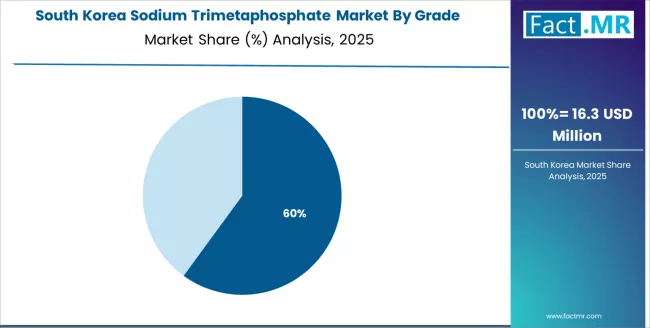
Demand for Sodium Trimetaphosphate in South Korea is projected to reach USD 42 million by 2035, expanding at a CAGR of 2.9%, driven by advanced industrial excellence and specialty chemical capabilities supporting technology manufacturing and comprehensive processing applications. The country's established chemical industry tradition and growing industrial market segments are creating demand for high-quality phosphate solutions that support operational performance and technical standards. Chemical suppliers and industrial manufacturers are maintaining comprehensive development capabilities to support diverse manufacturing requirements.
- Advanced industrial and specialty chemical programs are supporting demand for technical-grade phosphates that meet contemporary quality and performance standards
- Technology manufacturing and industrial processing programs are creating opportunities for specialized phosphate solutions that provide comprehensive processing support
- Industrial export excellence and chemical quality enhancement programs are facilitating adoption of advanced phosphate capabilities throughout major manufacturing regions
Japan Demonstrates Traditional Industrial Integration Excellence
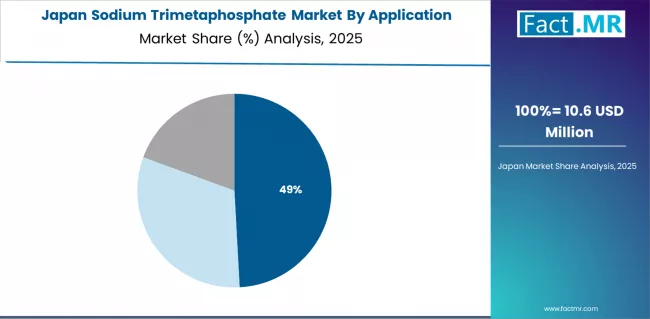
Demand for Sodium Trimetaphosphate in Japan is projected to reach USD 35 million by 2035, expanding at a CAGR of 2.8%, driven by traditional industrial integration excellence and comprehensive chemical technology capabilities supporting advanced manufacturing development and precision processing applications. The country's established industrial tradition and growing specialty chemical market segments are creating demand for high-quality phosphate solutions that support traditional processing practices and modern technical standards. Chemical suppliers and industrial manufacturers are maintaining comprehensive development capabilities to support diverse traditional industrial requirements.
- Traditional industrial integration and chemical technology programs are supporting demand for precision-grade phosphates that meet contemporary quality and traditional processing standards
- Manufacturing enhancement and chemical processing programs are creating opportunities for specialized phosphate solutions that provide comprehensive processing support
- Quality excellence and chemical enhancement programs are facilitating adoption of advanced phosphate capabilities throughout major industrial production regions
Europe Market Split by Country
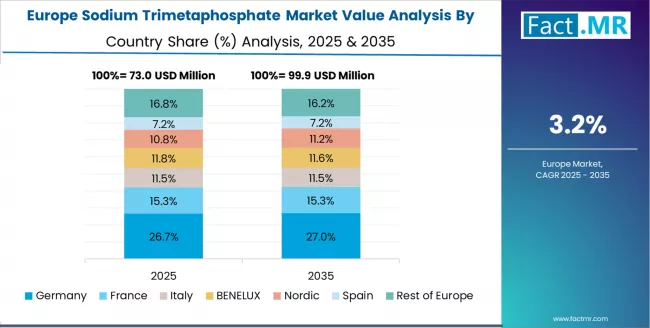
The sodium trimetaphosphate market in Europe is projected to grow from USD 82 million in 2025 to USD 115 million by 2035, registering a CAGR of 3.4% over the forecast period. Germany is expected to maintain its leadership position with a 31.2% market share in 2025, supported by its advanced chemical industry and comprehensive industrial processing capabilities including major facilities for established specialty chemical companies and manufacturing processors.
France follows with a 22.8% share in 2025, projected to reach 23.1% by 2035, driven by comprehensive industrial innovation programs and specialty chemical product development. The United Kingdom holds a 19.4% share in 2025, expected to maintain 19.1% by 2035 despite post-Brexit regulatory adjustments. Italy commands a 14.6% share, while Spain accounts for 8.2% in 2025. The Rest of Europe region is anticipated to gain momentum, expanding its collective share from 3.8% to 4.2% by 2035, attributed to increasing industrial processing in Nordic countries and emerging Eastern European manufacturers implementing specialty chemical strategies.
Premium Quality Standards Define Japanese Market Dynamics
Japanese sodium trimetaphosphate operations reflect the country's exacting quality standards and sophisticated industrial expectations. Major chemical and manufacturing companies including Ajinomoto, Shin-Etsu Chemical, and industrial processors maintain rigorous supplier qualification processes that often exceed international standards, requiring extensive documentation, purity testing, and facility audits that can take 12-18 months to complete. This creates high barriers for new suppliers but ensures consistent quality that supports premium industrial positioning.
The Japanese market demonstrates unique quality preferences, with significant demand for ultra-pure phosphate chemicals tailored to precision industrial applications including electronics manufacturing, food processing, and specialized industrial processes. Companies require specific purity profiles and performance characteristics that differ from Western applications, driving demand for specialized manufacturing and quality control capabilities.
Regulatory oversight through the Ministry of Economy, Trade and Industry emphasizes comprehensive chemical safety standards and environmental requirements that surpass most international benchmarks. The industrial chemical registration system requires detailed safety documentation, creating advantages for suppliers with transparent research data and comprehensive safety validation.
Supply chain management focuses on relationship-based partnerships rather than purely transactional procurement. Japanese companies typically maintain long-term supplier relationships spanning decades, with annual contract negotiations emphasizing quality consistency and performance reliability over price competition. This stability supports investment in specialized chemical production equipment tailored to Japanese industrial specifications.
Market Dynamics Drive Innovation in South Korea
South Korean sodium trimetaphosphate operations reflect the country's advanced chemical industry and export-oriented business model. Major chemical and industrial conglomerates including LG Chem, SK Chemicals, and processing-focused companies drive sophisticated chemical procurement strategies, establishing direct relationships with global suppliers to secure consistent quality and pricing for their industrial processing and chemical manufacturing operations targeting both domestic and international markets.
The Korean market demonstrates particular strength in applying sodium trimetaphosphate to advanced industrial applications, with companies developing innovative processing methods that integrate modern chemical technology with traditional industrial approaches and efficiency optimization. This innovation approach creates demand for specific chemical specifications that often exceed standard applications, requiring suppliers to adapt production and quality control techniques.
Regulatory frameworks emphasize chemical safety and export competitiveness, with Korean Chemical Registration and Evaluation standards often exceeding international requirements. This creates barriers for lower-quality suppliers but benefits established manufacturers who can demonstrate advanced purity and safety capabilities. The regulatory environment particularly favors suppliers with comprehensive documentation and environmental management systems.
Supply chain efficiency remains critical given Korea's position as an industrial export hub. Companies increasingly pursue long-term contracts with suppliers in North America, Europe, and specialized chemical regions to ensure reliable access to high-quality phosphate chemicals while managing regulatory compliance and foreign exchange risks. Advanced chemical processing and logistics investments support product quality preservation during production and distribution cycles.
Competitive Landscape of Sodium Trimetaphosphate Market
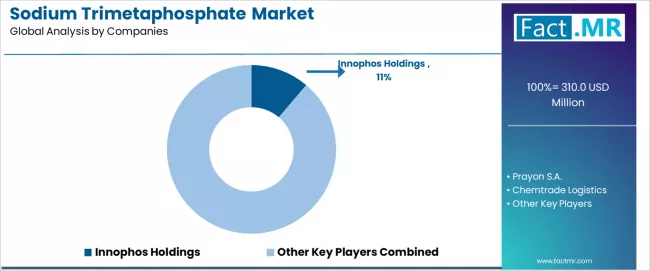
Profit pools are consolidating upstream in scaled phosphate processing systems and downstream in value-added specialty formulations for food processing, water treatment, and industrial applications. Value is migrating from basic phosphate manufacturing to specification-tight, application-ready chemical solutions where purity standards, regulatory compliance, and consistent performance characteristics command premiums.
Several archetypes set the pace: global specialty chemical suppliers defending share through production scale and quality reliability; multi-application processors that manage regulatory complexity and technical support; food-grade manufacturers with safety IP and food industry relationships; and technical specialists pulling volume in advanced industrial applications and specialized processing requirements.
Switching costs—regulatory approvals, quality validation, application development—stabilize market position for incumbents, while quality issues (contamination, performance variations, regulatory changes) and environmental trends reopen opportunities for superior chemical technologies. Consolidation and vertical integration continue; specialized procurement dominates industrial channels as food applications remain relationship-dependent. Market dynamics favor suppliers with comprehensive quality capabilities, regulatory expertise, and established industrial processing relationships.
The competitive environment presents both opportunities and constraints. Premium purity requirements create barriers for basic chemical manufacturers but establish standards that favor specialized phosphate producers over generic alternatives. Environmental compliance increasingly influences procurement decisions as industrial manufacturers seek transparent and sustainable chemical solutions.
| Stakeholder Type | Primary Advantage | Repeatable Plays |
|---|---|---|
| Global specialty chemical suppliers | Production scale, quality reliability | Long-term industrial partnerships, consistent purity standards, regulatory compliance |
| Multi-application processors | Regulatory complexity, technical support | Cross-industry solutions, application development, quality standardization |
| Food-grade manufacturers | Safety IP and food industry ties | Food safety validation, industry relationships, regulatory expertise |
| Technical specialists | Advanced applications, specialized processing | Technical differentiation, specialized markets, performance optimization |
Key Players in the Sodium Trimetaphosphate Market
- Innophos Holdings
- Prayon S.A.
- Chemtrade Logistics
- Solvay S.A.
- AkzoNobel N.V. (Specialty Lines)
- BASF SE (Specialty Chemicals)
- Lanxess AG
- Yara International (Adjacent Segment)
- Huber Engineered Materials
- Sanofi (Ingredient Lines)
Scope of the Report
| Items | Values |
|---|---|
| Quantitative Units | USD 310.0 Million |
| Product | Food & Bakery (Improvers), Water Treatment, Industrial (Dispersants) |
| Grade | Food-grade, Industrial-grade |
| Regions Covered | North America, Latin America, Europe, Asia Pacific, Middle East & Africa |
| Country Covered | United States, Germany, France, UK, South Korea, Japan, Mexico, and other 40+ countries |
| Key Companies Profiled | Innophos, Prayon, Chemtrade, Solvay, AkzoNobel, BASF, Lanxess, Yara, Huber Engineered, Sanofi |
| Additional Attributes | Dollar sales by application/grade/form, regional demand (NA, EU, APAC), competitive landscape, specialty chemicals adoption, regulatory compliance integration, and advanced processing innovations driving performance enhancement, quality optimization, and technical reliability |
Sodium Trimetaphosphate Market Segmentation
-
By Application :
- Food & Bakery (Improvers)
- Water Treatment
- Industrial (Dispersants)
-
By Grade :
- Food-grade
- Industrial-grade
-
By Form :
- Powder
- Solution
-
By Region :
- North America
- Europe
- Asia Pacific
- Latin America
- Middle East & Africa
Table of Content
- Executive Summary
- Global Market Outlook
- Demand to side Trends
- Supply to side Trends
- Technology Roadmap Analysis
- Analysis and Recommendations
- Market Overview
- Market Coverage / Taxonomy
- Market Definition / Scope / Limitations
- Market Background
- Market Dynamics
- Drivers
- Restraints
- Opportunity
- Trends
- Scenario Forecast
- Demand in Optimistic Scenario
- Demand in Likely Scenario
- Demand in Conservative Scenario
- Opportunity Map Analysis
- Product Life Cycle Analysis
- Supply Chain Analysis
- Investment Feasibility Matrix
- Value Chain Analysis
- PESTLE and Porter’s Analysis
- Regulatory Landscape
- Regional Parent Market Outlook
- Production and Consumption Statistics
- Import and Export Statistics
- Market Dynamics
- Global Market Analysis 2020 to 2024 and Forecast, 2025 to 2035
- Historical Market Size Value (USD Million) Analysis, 2020 to 2024
- Current and Future Market Size Value (USD Million) Projections, 2025 to 2035
- Y to o to Y Growth Trend Analysis
- Absolute $ Opportunity Analysis
- Global Market Pricing Analysis 2020 to 2024 and Forecast 2025 to 2035
- Global Market Analysis 2020 to 2024 and Forecast 2025 to 2035, By Application
- Introduction / Key Findings
- Historical Market Size Value (USD Million) Analysis By Application , 2020 to 2024
- Current and Future Market Size Value (USD Million) Analysis and Forecast By Application , 2025 to 2035
- Food & Bakery (Improvers)
- Water Treatment
- Industrial (Dispersants)
- Y to o to Y Growth Trend Analysis By Application , 2020 to 2024
- Absolute $ Opportunity Analysis By Application , 2025 to 2035
- Global Market Analysis 2020 to 2024 and Forecast 2025 to 2035, By Grade
- Introduction / Key Findings
- Historical Market Size Value (USD Million) Analysis By Grade, 2020 to 2024
- Current and Future Market Size Value (USD Million) Analysis and Forecast By Grade, 2025 to 2035
- Food-grade
- Industrial-grade
- Y to o to Y Growth Trend Analysis By Grade, 2020 to 2024
- Absolute $ Opportunity Analysis By Grade, 2025 to 2035
- Global Market Analysis 2020 to 2024 and Forecast 2025 to 2035, By Form
- Introduction / Key Findings
- Historical Market Size Value (USD Million) Analysis By Form, 2020 to 2024
- Current and Future Market Size Value (USD Million) Analysis and Forecast By Form, 2025 to 2035
- Powder
- Solution
- Y to o to Y Growth Trend Analysis By Form, 2020 to 2024
- Absolute $ Opportunity Analysis By Form, 2025 to 2035
- Global Market Analysis 2020 to 2024 and Forecast 2025 to 2035, By Region
- Introduction
- Historical Market Size Value (USD Million) Analysis By Region, 2020 to 2024
- Current Market Size Value (USD Million) Analysis and Forecast By Region, 2025 to 2035
- North America
- Latin America
- Western Europe
- Eastern Europe
- East Asia
- South Asia and Pacific
- Middle East & Africa
- Market Attractiveness Analysis By Region
- North America Market Analysis 2020 to 2024 and Forecast 2025 to 2035, By Country
- Historical Market Size Value (USD Million) Trend Analysis By Market Taxonomy, 2020 to 2024
- Market Size Value (USD Million) Forecast By Market Taxonomy, 2025 to 2035
- By Country
- USA
- Canada
- Mexico
- By Application
- By Grade
- By Form
- By Country
- Market Attractiveness Analysis
- By Country
- By Application
- By Grade
- By Form
- Key Takeaways
- Latin America Market Analysis 2020 to 2024 and Forecast 2025 to 2035, By Country
- Historical Market Size Value (USD Million) Trend Analysis By Market Taxonomy, 2020 to 2024
- Market Size Value (USD Million) Forecast By Market Taxonomy, 2025 to 2035
- By Country
- Brazil
- Chile
- Rest of Latin America
- By Application
- By Grade
- By Form
- By Country
- Market Attractiveness Analysis
- By Country
- By Application
- By Grade
- By Form
- Key Takeaways
- Western Europe Market Analysis 2020 to 2024 and Forecast 2025 to 2035, By Country
- Historical Market Size Value (USD Million) Trend Analysis By Market Taxonomy, 2020 to 2024
- Market Size Value (USD Million) Forecast By Market Taxonomy, 2025 to 2035
- By Country
- Germany
- UK
- Italy
- Spain
- France
- Nordic
- BENELUX
- Rest of Western Europe
- By Application
- By Grade
- By Form
- By Country
- Market Attractiveness Analysis
- By Country
- By Application
- By Grade
- By Form
- Key Takeaways
- Eastern Europe Market Analysis 2020 to 2024 and Forecast 2025 to 2035, By Country
- Historical Market Size Value (USD Million) Trend Analysis By Market Taxonomy, 2020 to 2024
- Market Size Value (USD Million) Forecast By Market Taxonomy, 2025 to 2035
- By Country
- Russia
- Poland
- Hungary
- Balkan & Baltic
- Rest of Eastern Europe
- By Application
- By Grade
- By Form
- By Country
- Market Attractiveness Analysis
- By Country
- By Application
- By Grade
- By Form
- Key Takeaways
- East Asia Market Analysis 2020 to 2024 and Forecast 2025 to 2035, By Country
- Historical Market Size Value (USD Million) Trend Analysis By Market Taxonomy, 2020 to 2024
- Market Size Value (USD Million) Forecast By Market Taxonomy, 2025 to 2035
- By Country
- China
- Japan
- South Korea
- By Application
- By Grade
- By Form
- By Country
- Market Attractiveness Analysis
- By Country
- By Application
- By Grade
- By Form
- Key Takeaways
- South Asia and Pacific Market Analysis 2020 to 2024 and Forecast 2025 to 2035, By Country
- Historical Market Size Value (USD Million) Trend Analysis By Market Taxonomy, 2020 to 2024
- Market Size Value (USD Million) Forecast By Market Taxonomy, 2025 to 2035
- By Country
- India
- ASEAN
- Australia & New Zealand
- Rest of South Asia and Pacific
- By Application
- By Grade
- By Form
- By Country
- Market Attractiveness Analysis
- By Country
- By Application
- By Grade
- By Form
- Key Takeaways
- Middle East & Africa Market Analysis 2020 to 2024 and Forecast 2025 to 2035, By Country
- Historical Market Size Value (USD Million) Trend Analysis By Market Taxonomy, 2020 to 2024
- Market Size Value (USD Million) Forecast By Market Taxonomy, 2025 to 2035
- By Country
- Kingdom of Saudi Arabia
- Other GCC Countries
- Turkiye
- South Africa
- Other African Union
- Rest of Middle East & Africa
- By Application
- By Grade
- By Form
- By Country
- Market Attractiveness Analysis
- By Country
- By Application
- By Grade
- By Form
- Key Takeaways
- Key Countries Market Analysis
- USA
- Pricing Analysis
- Market Share Analysis, 2024
- By Application
- By Grade
- By Form
- Canada
- Pricing Analysis
- Market Share Analysis, 2024
- By Application
- By Grade
- By Form
- Mexico
- Pricing Analysis
- Market Share Analysis, 2024
- By Application
- By Grade
- By Form
- Brazil
- Pricing Analysis
- Market Share Analysis, 2024
- By Application
- By Grade
- By Form
- Chile
- Pricing Analysis
- Market Share Analysis, 2024
- By Application
- By Grade
- By Form
- Germany
- Pricing Analysis
- Market Share Analysis, 2024
- By Application
- By Grade
- By Form
- UK
- Pricing Analysis
- Market Share Analysis, 2024
- By Application
- By Grade
- By Form
- Italy
- Pricing Analysis
- Market Share Analysis, 2024
- By Application
- By Grade
- By Form
- Spain
- Pricing Analysis
- Market Share Analysis, 2024
- By Application
- By Grade
- By Form
- France
- Pricing Analysis
- Market Share Analysis, 2024
- By Application
- By Grade
- By Form
- India
- Pricing Analysis
- Market Share Analysis, 2024
- By Application
- By Grade
- By Form
- ASEAN
- Pricing Analysis
- Market Share Analysis, 2024
- By Application
- By Grade
- By Form
- Australia & New Zealand
- Pricing Analysis
- Market Share Analysis, 2024
- By Application
- By Grade
- By Form
- China
- Pricing Analysis
- Market Share Analysis, 2024
- By Application
- By Grade
- By Form
- Japan
- Pricing Analysis
- Market Share Analysis, 2024
- By Application
- By Grade
- By Form
- South Korea
- Pricing Analysis
- Market Share Analysis, 2024
- By Application
- By Grade
- By Form
- Russia
- Pricing Analysis
- Market Share Analysis, 2024
- By Application
- By Grade
- By Form
- Poland
- Pricing Analysis
- Market Share Analysis, 2024
- By Application
- By Grade
- By Form
- Hungary
- Pricing Analysis
- Market Share Analysis, 2024
- By Application
- By Grade
- By Form
- Kingdom of Saudi Arabia
- Pricing Analysis
- Market Share Analysis, 2024
- By Application
- By Grade
- By Form
- Turkiye
- Pricing Analysis
- Market Share Analysis, 2024
- By Application
- By Grade
- By Form
- South Africa
- Pricing Analysis
- Market Share Analysis, 2024
- By Application
- By Grade
- By Form
- USA
- Market Structure Analysis
- Competition Dashboard
- Competition Benchmarking
- Market Share Analysis of Top Players
- By Regional
- By Application
- By Grade
- By Form
- Competition Analysis
- Competition Deep Dive
- Innophos Holdings
- Overview
- Product Portfolio
- Profitability by Market Segments (Product/Age /Sales Channel/Region)
- Sales Footprint
- Strategy Overview
- Marketing Strategy
- Product Strategy
- Channel Strategy
- Prayon S.A.
- Chemtrade Logistics
- Solvay S.A.
- AkzoNobel N.V. (Specialty Lines)
- BASF SE (Specialty Chemicals)
- Lanxess AG
- Yara International (Adjacent Segment)
- Huber Engineered Materials
- Sanofi (Ingredient Lines)
- Innophos Holdings
- Competition Deep Dive
- Assumptions & Acronyms Used
- Research Methodology
List Of Table
- Table 1: Global Market Value (USD Million) Forecast by Region, 2020 to 2035
- Table 2: Global Market Value (USD Million) Forecast by Application , 2020 to 2035
- Table 3: Global Market Value (USD Million) Forecast by Grade, 2020 to 2035
- Table 4: Global Market Value (USD Million) Forecast by Form, 2020 to 2035
- Table 5: North America Market Value (USD Million) Forecast by Country, 2020 to 2035
- Table 6: North America Market Value (USD Million) Forecast by Application , 2020 to 2035
- Table 7: North America Market Value (USD Million) Forecast by Grade, 2020 to 2035
- Table 8: North America Market Value (USD Million) Forecast by Form, 2020 to 2035
- Table 9: Latin America Market Value (USD Million) Forecast by Country, 2020 to 2035
- Table 10: Latin America Market Value (USD Million) Forecast by Application , 2020 to 2035
- Table 11: Latin America Market Value (USD Million) Forecast by Grade, 2020 to 2035
- Table 12: Latin America Market Value (USD Million) Forecast by Form, 2020 to 2035
- Table 13: Western Europe Market Value (USD Million) Forecast by Country, 2020 to 2035
- Table 14: Western Europe Market Value (USD Million) Forecast by Application , 2020 to 2035
- Table 15: Western Europe Market Value (USD Million) Forecast by Grade, 2020 to 2035
- Table 16: Western Europe Market Value (USD Million) Forecast by Form, 2020 to 2035
- Table 17: Eastern Europe Market Value (USD Million) Forecast by Country, 2020 to 2035
- Table 18: Eastern Europe Market Value (USD Million) Forecast by Application , 2020 to 2035
- Table 19: Eastern Europe Market Value (USD Million) Forecast by Grade, 2020 to 2035
- Table 20: Eastern Europe Market Value (USD Million) Forecast by Form, 2020 to 2035
- Table 21: East Asia Market Value (USD Million) Forecast by Country, 2020 to 2035
- Table 22: East Asia Market Value (USD Million) Forecast by Application , 2020 to 2035
- Table 23: East Asia Market Value (USD Million) Forecast by Grade, 2020 to 2035
- Table 24: East Asia Market Value (USD Million) Forecast by Form, 2020 to 2035
- Table 25: South Asia and Pacific Market Value (USD Million) Forecast by Country, 2020 to 2035
- Table 26: South Asia and Pacific Market Value (USD Million) Forecast by Application , 2020 to 2035
- Table 27: South Asia and Pacific Market Value (USD Million) Forecast by Grade, 2020 to 2035
- Table 28: South Asia and Pacific Market Value (USD Million) Forecast by Form, 2020 to 2035
- Table 29: Middle East & Africa Market Value (USD Million) Forecast by Country, 2020 to 2035
- Table 30: Middle East & Africa Market Value (USD Million) Forecast by Application , 2020 to 2035
- Table 31: Middle East & Africa Market Value (USD Million) Forecast by Grade, 2020 to 2035
- Table 32: Middle East & Africa Market Value (USD Million) Forecast by Form, 2020 to 2035
List Of Figures
- Figure 1: Global Market Pricing Analysis
- Figure 2: Global Market Value (USD Million) Forecast 2020-2035
- Figure 3: Global Market Value Share and BPS Analysis by Application , 2025 and 2035
- Figure 4: Global Market Y to o to Y Growth Comparison by Application , 2025-2035
- Figure 5: Global Market Attractiveness Analysis by Application
- Figure 6: Global Market Value Share and BPS Analysis by Grade, 2025 and 2035
- Figure 7: Global Market Y to o to Y Growth Comparison by Grade, 2025-2035
- Figure 8: Global Market Attractiveness Analysis by Grade
- Figure 9: Global Market Value Share and BPS Analysis by Form, 2025 and 2035
- Figure 10: Global Market Y to o to Y Growth Comparison by Form, 2025-2035
- Figure 11: Global Market Attractiveness Analysis by Form
- Figure 12: Global Market Value (USD Million) Share and BPS Analysis by Region, 2025 and 2035
- Figure 13: Global Market Y to o to Y Growth Comparison by Region, 2025-2035
- Figure 14: Global Market Attractiveness Analysis by Region
- Figure 15: North America Market Incremental Dollar Opportunity, 2025-2035
- Figure 16: Latin America Market Incremental Dollar Opportunity, 2025-2035
- Figure 17: Western Europe Market Incremental Dollar Opportunity, 2025-2035
- Figure 18: Eastern Europe Market Incremental Dollar Opportunity, 2025-2035
- Figure 19: East Asia Market Incremental Dollar Opportunity, 2025-2035
- Figure 20: South Asia and Pacific Market Incremental Dollar Opportunity, 2025-2035
- Figure 21: Middle East & Africa Market Incremental Dollar Opportunity, 2025-2035
- Figure 22: North America Market Value Share and BPS Analysis by Country, 2025 and 2035
- Figure 23: North America Market Value Share and BPS Analysis by Application , 2025 and 2035
- Figure 24: North America Market Y to o to Y Growth Comparison by Application , 2025-2035
- Figure 25: North America Market Attractiveness Analysis by Application
- Figure 26: North America Market Value Share and BPS Analysis by Grade, 2025 and 2035
- Figure 27: North America Market Y to o to Y Growth Comparison by Grade, 2025-2035
- Figure 28: North America Market Attractiveness Analysis by Grade
- Figure 29: North America Market Value Share and BPS Analysis by Form, 2025 and 2035
- Figure 30: North America Market Y to o to Y Growth Comparison by Form, 2025-2035
- Figure 31: North America Market Attractiveness Analysis by Form
- Figure 32: Latin America Market Value Share and BPS Analysis by Country, 2025 and 2035
- Figure 33: Latin America Market Value Share and BPS Analysis by Application , 2025 and 2035
- Figure 34: Latin America Market Y to o to Y Growth Comparison by Application , 2025-2035
- Figure 35: Latin America Market Attractiveness Analysis by Application
- Figure 36: Latin America Market Value Share and BPS Analysis by Grade, 2025 and 2035
- Figure 37: Latin America Market Y to o to Y Growth Comparison by Grade, 2025-2035
- Figure 38: Latin America Market Attractiveness Analysis by Grade
- Figure 39: Latin America Market Value Share and BPS Analysis by Form, 2025 and 2035
- Figure 40: Latin America Market Y to o to Y Growth Comparison by Form, 2025-2035
- Figure 41: Latin America Market Attractiveness Analysis by Form
- Figure 42: Western Europe Market Value Share and BPS Analysis by Country, 2025 and 2035
- Figure 43: Western Europe Market Value Share and BPS Analysis by Application , 2025 and 2035
- Figure 44: Western Europe Market Y to o to Y Growth Comparison by Application , 2025-2035
- Figure 45: Western Europe Market Attractiveness Analysis by Application
- Figure 46: Western Europe Market Value Share and BPS Analysis by Grade, 2025 and 2035
- Figure 47: Western Europe Market Y to o to Y Growth Comparison by Grade, 2025-2035
- Figure 48: Western Europe Market Attractiveness Analysis by Grade
- Figure 49: Western Europe Market Value Share and BPS Analysis by Form, 2025 and 2035
- Figure 50: Western Europe Market Y to o to Y Growth Comparison by Form, 2025-2035
- Figure 51: Western Europe Market Attractiveness Analysis by Form
- Figure 52: Eastern Europe Market Value Share and BPS Analysis by Country, 2025 and 2035
- Figure 53: Eastern Europe Market Value Share and BPS Analysis by Application , 2025 and 2035
- Figure 54: Eastern Europe Market Y to o to Y Growth Comparison by Application , 2025-2035
- Figure 55: Eastern Europe Market Attractiveness Analysis by Application
- Figure 56: Eastern Europe Market Value Share and BPS Analysis by Grade, 2025 and 2035
- Figure 57: Eastern Europe Market Y to o to Y Growth Comparison by Grade, 2025-2035
- Figure 58: Eastern Europe Market Attractiveness Analysis by Grade
- Figure 59: Eastern Europe Market Value Share and BPS Analysis by Form, 2025 and 2035
- Figure 60: Eastern Europe Market Y to o to Y Growth Comparison by Form, 2025-2035
- Figure 61: Eastern Europe Market Attractiveness Analysis by Form
- Figure 62: East Asia Market Value Share and BPS Analysis by Country, 2025 and 2035
- Figure 63: East Asia Market Value Share and BPS Analysis by Application , 2025 and 2035
- Figure 64: East Asia Market Y to o to Y Growth Comparison by Application , 2025-2035
- Figure 65: East Asia Market Attractiveness Analysis by Application
- Figure 66: East Asia Market Value Share and BPS Analysis by Grade, 2025 and 2035
- Figure 67: East Asia Market Y to o to Y Growth Comparison by Grade, 2025-2035
- Figure 68: East Asia Market Attractiveness Analysis by Grade
- Figure 69: East Asia Market Value Share and BPS Analysis by Form, 2025 and 2035
- Figure 70: East Asia Market Y to o to Y Growth Comparison by Form, 2025-2035
- Figure 71: East Asia Market Attractiveness Analysis by Form
- Figure 72: South Asia and Pacific Market Value Share and BPS Analysis by Country, 2025 and 2035
- Figure 73: South Asia and Pacific Market Value Share and BPS Analysis by Application , 2025 and 2035
- Figure 74: South Asia and Pacific Market Y to o to Y Growth Comparison by Application , 2025-2035
- Figure 75: South Asia and Pacific Market Attractiveness Analysis by Application
- Figure 76: South Asia and Pacific Market Value Share and BPS Analysis by Grade, 2025 and 2035
- Figure 77: South Asia and Pacific Market Y to o to Y Growth Comparison by Grade, 2025-2035
- Figure 78: South Asia and Pacific Market Attractiveness Analysis by Grade
- Figure 79: South Asia and Pacific Market Value Share and BPS Analysis by Form, 2025 and 2035
- Figure 80: South Asia and Pacific Market Y to o to Y Growth Comparison by Form, 2025-2035
- Figure 81: South Asia and Pacific Market Attractiveness Analysis by Form
- Figure 82: Middle East & Africa Market Value Share and BPS Analysis by Country, 2025 and 2035
- Figure 83: Middle East & Africa Market Value Share and BPS Analysis by Application , 2025 and 2035
- Figure 84: Middle East & Africa Market Y to o to Y Growth Comparison by Application , 2025-2035
- Figure 85: Middle East & Africa Market Attractiveness Analysis by Application
- Figure 86: Middle East & Africa Market Value Share and BPS Analysis by Grade, 2025 and 2035
- Figure 87: Middle East & Africa Market Y to o to Y Growth Comparison by Grade, 2025-2035
- Figure 88: Middle East & Africa Market Attractiveness Analysis by Grade
- Figure 89: Middle East & Africa Market Value Share and BPS Analysis by Form, 2025 and 2035
- Figure 90: Middle East & Africa Market Y to o to Y Growth Comparison by Form, 2025-2035
- Figure 91: Middle East & Africa Market Attractiveness Analysis by Form
- Figure 92: Global Market - Tier Structure Analysis
- Figure 93: Global Market - Company Share Analysis
- FAQs -
How big is the sodium trimetaphosphate market in 2025?
The global sodium trimetaphosphate market is estimated to be valued at USD 310.0 million in 2025.
What will be the size of sodium trimetaphosphate market in 2035?
The market size for the sodium trimetaphosphate market is projected to reach USD 460.0 million by 2035.
How much will be the sodium trimetaphosphate market growth between 2025 and 2035?
The sodium trimetaphosphate market is expected to grow at a 4.0% CAGR between 2025 and 2035.
What are the key product types in the sodium trimetaphosphate market?
The key product types in sodium trimetaphosphate market are food & bakery (improvers), water treatment and industrial (dispersants).
Which grade segment to contribute significant share in the sodium trimetaphosphate market in 2025?
In terms of grade, food-grade segment to command 61.0% share in the sodium trimetaphosphate market in 2025.